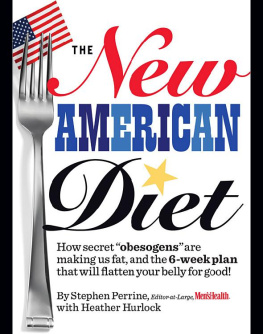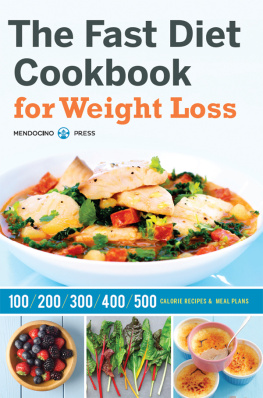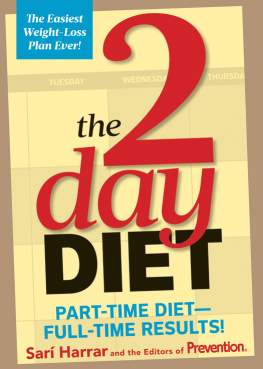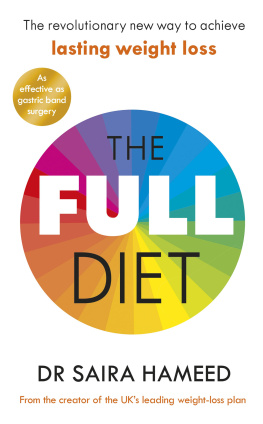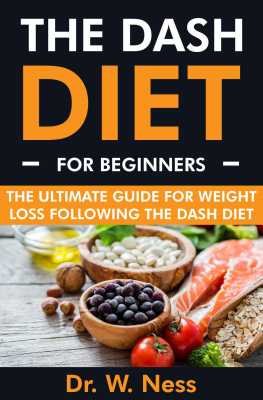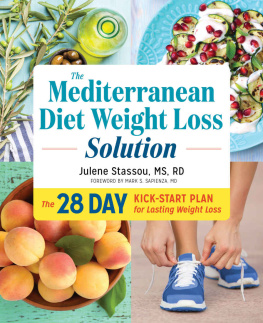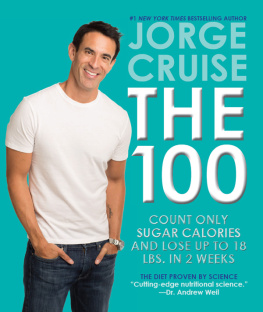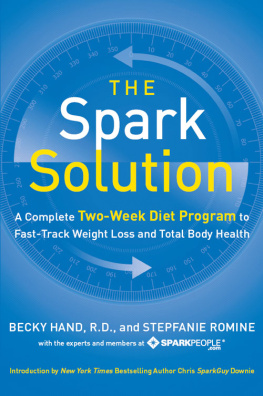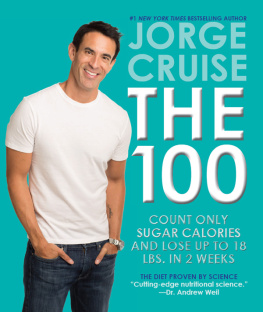We believe The New American Diet carries an important message about the future of our health, our children, and our environment. And we are deeply thankful to have this message supported by the most dedicated, talented, hard-working group of individuals in the publishing industry. In particular:
Maria Rodale and the Rodale family, who have been fighting to awaken us to the connection between our health and our environment for more than 60 years. We hope this book brings us one step closer to realizing a healthier future.
David Zinczenko, whose support, encouragement and grace under pressure have made this and all of our endeavors possible.
The staff of Best Life magazine, in particular Tyler Graham, who deeply influenced this work; Heather Jones, whose graphics appear throughout it; and Amy Ciauro, whose editorial input has proven invaluable.
The editors of Mens Health and Womens Health magazines, especially Adam Campbell, for his exercise expertise; Matt Goulding, for his nutritional insights; and Bill Phillips and Steve Borkowski for their Web and marketing support.
Karen Rinaldi, Chris Krogermeier, Beth Lamb, Julie Geiringer, Erin Williams, and the team at Rodale Books.
George Karabotsos, Debbie McHugh, Davia Smith, Mark Michaelson, Joel Weber, Theresa Dougherty, and the team at Mens Health Books.
Fotoulla Euripidou, Meridith Lampert and Philavong Chanda for their dedication to getting just the facts, maam. Allison Falkenberry, Agnes Hansdorfer, Brett LeVecchio, Erin Clinton,
Allison Keane, and Robin Shallow, who have helped us to spread the word about The New American Diet.
Alex von Bidder and Elaine Kaufman, for their heaping plates of wisdom and encouragement.
Tom Beller, Anthony DeCurtis, Billy Goldberg, Peter Greenberg, Mark Leyner, David Mamet, Colin McEnroe, Hugh ONeill, Richard Phibbs, Donovan Webster, and the many, many other writers and artists who helped to make Best Life into a great ride in a luxury vehicle.
And the authors and activists who continue to inspire us with their dedication to the environment, including Charlie Moore, Susan Casey, Robert F. Kennedy Jr., and the team at Waterkeepers Alliance.
And finally, Heather Hurlock says: Id like to thank my husband, Eric, for his love, support, and willingness to adopt the New American Diet; my parents, Mary and Lou, for being the best grandparents ever; Jen Holman for her panna cotta recipe; and the librarians at Rodale for tirelessly helping me track down studies and statistics.
Stephen Perrine says: Thanks to my loving and supportive family, especially my wife, Jennifer. The best meal Ill ever have is the next one I share with you.
Where to find the best, cheapest, healthiest foods on the planet
Changing how you eat to reduce your exposure to obesogensby including more grass-fed meats, environmentally sustainable fish, and pesticide-free producemay seem like a diffcult and expensive notion. Its not. In fact, quite the opposite.
Eating food and drinking beverages that are lower in obesogens takes a little bit of forethought, but a few simple steps will save you money, stress, and, most important of all, pounds. It will protect you, your family, and generations to
come from obesity and disease. And it will make a positive impact on your mood and brain function.
How to Eat Local
Start simple
Begin by eating one meal a week made from all local ingredients. Switch to local cider instead of Florida orange juice (unless you live in Florida). Step up your effort during peak growing season, when local food will be more abundant. In most places, thats late summer and early fall. Freeze fruits and vegetables youve bought in season so you can enjoy their health benefits year-round.
Join a farm
For an annual fee thats a fraction of your grocery budget, you can become a member of a local community supported agriculture (CSA) farm. It will deliver a selection of fresh goodies every week. Some CSAs offer meat and flowers as well as produce. localharvest.org/csa
Shop at farmers markets
Theyre the best source for local food, and the U.S. now has more than 4,000 of them. ams.usda.gov/farmers markets/ map.htm
Eat green when you eat out
Visit eatwellguide.org to find restaurants serving local, sustainable, organic foods on the road. It even has a trip planner!
How to Find Grass-fed Beef at a Grocery Store Near You
To find grass-fed beef close to home, go to eatwild.com for a state-by-state directory. And look for these brands in a grocery store near you.
Panorama Meats
One of the largest producers of grass-fed beef in the country, Panorama Meats is a consortium of ranchers who distribute to Trader Joes and Whole Foods throughout the West. They pasture-raise primarily Black Angus and Red Angus cattle. panoramameats.com
Country Natural Beef
More than 100 ranches make up Country Natural Beef, and collectively, they let their cattleBritish breeds, Hereford, and Angusgraze on more than 4 million acres. You can find their ranch families range-raised beef in stores such as Thriftway, PCC Natural Market, and New Season Markets in 11 states in the West, Midwest, and South. countrynaturalbeef.com
Tallgrass Beef
Scientists at Tallgrass use ultrasound technology to see inside cattle, which, amazingly, allows them to detect the amount of marbling in the animals muscles. Based in Kansas, the company distributes throughout the Midwest, East Coast, and Southeast. tallgrassbeef.com
Niman Ranch
This network of more than 600 independent farmers and ranchers is probably the easiest to find nationally, as the brand is sold in more than 800 stores and served in approximately 5,000 restaurants. Its free-range pork is served at the fast-food chain Chipotle Mexican Grill. nimanranch.com
Pacific Village
The ranchers behind Pacific Village used to feed their cattle grain and send them to feedlotsuntil an Argentinean exchange student inspired them to raise their cattle entirely on grass instead. Since 2002, Pacific Village has teamed with New Seasons, a Northwest natural-food store, to bring grassfinished beef to market. newseasonsmarket.com
How to Improve Your Diet While Saving Cash and Time
Buy direct
The number of community supported agriculture farms (CSAs) offering individual food subscriptions has grown from roughly 600 in the 1990s to more than 2,200 today. A typical CSA charges $400 to $600 for up to 6 months of freshly harvested fruits, vegetables, herbs, flowers, and even meat. A farm called 2Silos near Columbus, Ohio, offers a protein share: A typical months bounty, for $60, might include 10 pounds of meat, including grass-fed steaks, breakfast sausage, free-range chicken, and lamb roast, plus two dozen eggs and extras such as soup bones and organ meats. The DeBerry Farm in Oakland, Maryland, offers a box of vegetables, herbs, berries, and melons for about $20 a week. Some deliver, while others drop boxes at a central location. Either way, you avoid the shopping-cart derby. According to the Bureau of Labor Statistics, the average American family of four spends about $2,100 a year on meat and vegetables. That makes the annual $1,700 a year a hypothetical family would spend at 2Silos and DeBerry look like a pretty good deal. To find a CSA, go to localharvest.org. The site also has a directory of more than 9,000 farms that offer provisions ranging from honey and cheese to whole pigs.
Make it automatic
Set up a shopping list at a site such as peapod.com or fresh direct.com in the East, or winderfarms.com in the West, and you can do a weeks shopping in minutes and have the goods delivered. For nonperishable items, consider amazon.com, where signing up for regular deliveries will knock 15 percent off your bill.

